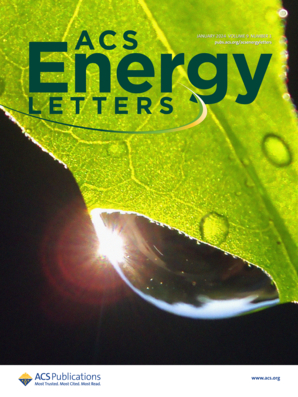Go with CO: A Case for Targeting Carbon Monoxide As a Reactive Carbon Capture Product
IF 19.3
1区 材料科学
Q1 CHEMISTRY, PHYSICAL
引用次数: 0
Abstract
This study is relevant to reactive carbon capture using aqueous alkaline capture solutions, where captured CO2 is electrochemically released from a capture solution and then upgraded into commodity chemicals in an electrolyzer. The commercial viability of this form of reactive carbon capture demands that the electrolyzer effluent that is returned to the capture unit be sufficiently alkaline to effectively capture CO2 from air or a point source. Here, we introduce “electron-alkalinity efficiency” (EA%) to correlate OH– production to electrons consumed during the electrolysis of CO2. We show that the maximum EA% value for CO production is 100%, but is less than 50% for the production of HCOO–, CH4, and C2H4. This outcome implies that the electrolytic production of CO yields the highest CO2 capture efficiency. To support this claim, we modeled a 1-m2 electrolyzer producing CO at a current density of 200 mA cm–2, 100% Faradaic efficiency for CO, and 100% CO2 utilization, resulting in an OH– production rate of 75 mol h–1. No other CO2 reduction products (HCOO–, CH4, and C2H4) generate this level of alkalinity without operating at far more extreme current densities or larger scales. We therefore recommend to “go with CO” for reactive carbon capture.

以一氧化碳为目标:一氧化碳作为反应性碳捕获产品的案例
这项研究与使用碱性水捕集液的活性碳捕集有关,在这种捕集液中,捕获的二氧化碳通过电化学方式从捕集液中释放出来,然后在电解槽中升级为商品化学品。这种形式的反应性碳捕获的商业可行性要求返回到捕获单元的电解槽流出物具有足够的碱性,以有效地捕获来自空气或点源的二氧化碳。在这里,我们引入了“电子碱度效率”(EA%)来将OH -的产生与二氧化碳电解过程中消耗的电子联系起来。我们发现CO的最大EA%值为100%,而HCOO -、CH4和C2H4的最大EA%值小于50%。这一结果表明,CO的电解生产产生最高的CO2捕获效率。为了支持这一说法,我们模拟了一个1平方米的电解槽,在200 mA cm-2的电流密度下产生CO, CO的法拉第效率为100%,CO2利用率为100%,从而产生75 mol h-1的OH -产率。没有其他的二氧化碳还原产物(HCOO -, CH4和C2H4)在没有更极端的电流密度或更大的规模下产生这样的碱度。因此,我们建议“使用CO”进行活性碳捕获。
本文章由计算机程序翻译,如有差异,请以英文原文为准。
求助全文
约1分钟内获得全文
求助全文
来源期刊

ACS Energy Letters
Energy-Renewable Energy, Sustainability and the Environment
CiteScore
31.20
自引率
5.00%
发文量
469
审稿时长
1 months
期刊介绍:
ACS Energy Letters is a monthly journal that publishes papers reporting new scientific advances in energy research. The journal focuses on topics that are of interest to scientists working in the fundamental and applied sciences. Rapid publication is a central criterion for acceptance, and the journal is known for its quick publication times, with an average of 4-6 weeks from submission to web publication in As Soon As Publishable format.
ACS Energy Letters is ranked as the number one journal in the Web of Science Electrochemistry category. It also ranks within the top 10 journals for Physical Chemistry, Energy & Fuels, and Nanoscience & Nanotechnology.
The journal offers several types of articles, including Letters, Energy Express, Perspectives, Reviews, Editorials, Viewpoints and Energy Focus. Additionally, authors have the option to submit videos that summarize or support the information presented in a Perspective or Review article, which can be highlighted on the journal's website. ACS Energy Letters is abstracted and indexed in Chemical Abstracts Service/SciFinder, EBSCO-summon, PubMed, Web of Science, Scopus and Portico.
 求助内容:
求助内容: 应助结果提醒方式:
应助结果提醒方式:


